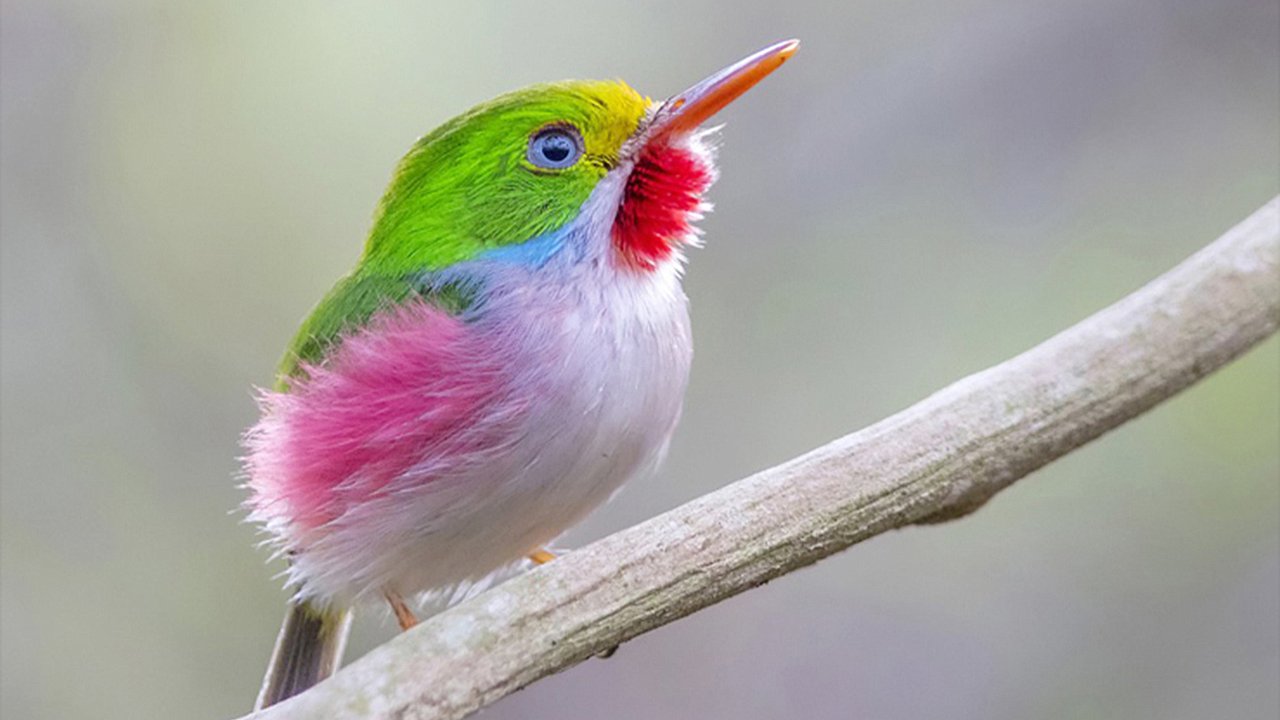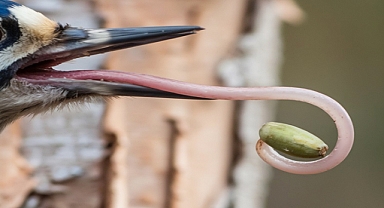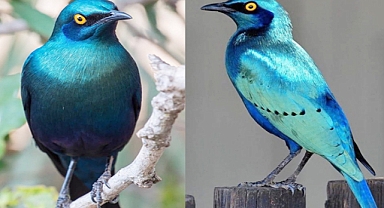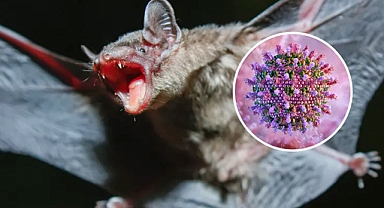With its dazzling colors and endearing size, the Cuban tody is one of the Caribbean’s most enchanting birds. Discover how this vibrant species lives, feeds, nests, and thrives in the lush landscapes of Cuba. This charming bird is known for its broad, flat bill, bright green upper body, shimmering wings and tail, ruby-red throat and mandibles, soft pink flanks, sky-blue patches on the sides of its neck, and a snow-white belly with a yellow under-tail. It’s the most strikingly colored member of its family and also boasts the smallest beak among its relatives. The Cuban tody’s colorful plumage not only makes it visually remarkable but also serves as natural camouflage amid tropical plants and blossoms.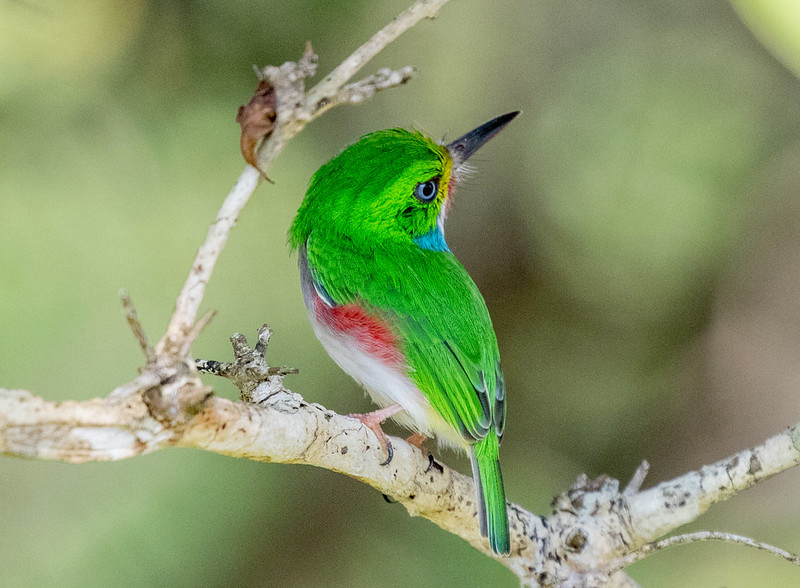 Despite its vibrant appearance, spotting a Cuban tody in the wild is no easy task. Measuring just 34 mm from beak to the back of the head, and with a cranium barely 9 mm thick, it weighs only 6 to 6.5 grams—about the size of a stress ball. These birds are quick, agile, and prefer dense vegetation, making them elusive to photographers. When not perched in shady foliage, they dart through the air too fast for most cameras to catch.Cuban todies are also known for their unique vocalizations. They make three main types of sounds: a frequent, high-pitched “totting” call, a less common low-frequency note, and a wing-generated sound. Their typical song is a repetitive "tot-tot-tot" call that resembles an alarm. Interestingly, regional variations in their songs between eastern and western populations are believed to be genetically based.
Despite its vibrant appearance, spotting a Cuban tody in the wild is no easy task. Measuring just 34 mm from beak to the back of the head, and with a cranium barely 9 mm thick, it weighs only 6 to 6.5 grams—about the size of a stress ball. These birds are quick, agile, and prefer dense vegetation, making them elusive to photographers. When not perched in shady foliage, they dart through the air too fast for most cameras to catch.Cuban todies are also known for their unique vocalizations. They make three main types of sounds: a frequent, high-pitched “totting” call, a less common low-frequency note, and a wing-generated sound. Their typical song is a repetitive "tot-tot-tot" call that resembles an alarm. Interestingly, regional variations in their songs between eastern and western populations are believed to be genetically based.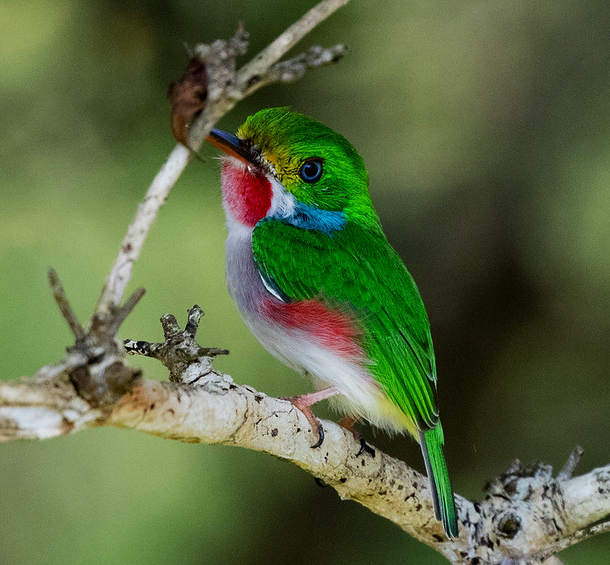 These birds are skilled insectivores and forage energetically throughout the day, often hunting nine feet or more above ground level. Their diet primarily consists of insects, but they also consume spiders, small lizards, and occasional fruit. Incredibly, they can catch up to one or two insects every minute. Their closest avian companions in habitat include the Loggerhead Kingbird and the Cuban Green Woodpecker. Natural predators are few, with mongooses and humans being their main threats.Cuban todies are resourceful nesters and typically build their homes in embankments or hollow tree trunks. Excavation begins as early as September, with both male and female birds taking turns digging tunnels. Interestingly, the first tunnels are used as night shelters while the egg-laying chambers are still under construction. The birds use a mix of grass, feathers, algae, and lichen to seal the tunnel walls and create curved entryways that deter predators. These burrows end in nesting chambers that usually hold two or three glossy, white, fragile-shelled eggs—the smallest among todies.Breeding season typically spans from April to June. During courtship, male todies show affection by exclusively feeding their mates. These bonding rituals mirror mating behaviors seen in other Cuban and North American bird species. Once bonded, the pair continues to share nesting and foraging responsibilities.
These birds are skilled insectivores and forage energetically throughout the day, often hunting nine feet or more above ground level. Their diet primarily consists of insects, but they also consume spiders, small lizards, and occasional fruit. Incredibly, they can catch up to one or two insects every minute. Their closest avian companions in habitat include the Loggerhead Kingbird and the Cuban Green Woodpecker. Natural predators are few, with mongooses and humans being their main threats.Cuban todies are resourceful nesters and typically build their homes in embankments or hollow tree trunks. Excavation begins as early as September, with both male and female birds taking turns digging tunnels. Interestingly, the first tunnels are used as night shelters while the egg-laying chambers are still under construction. The birds use a mix of grass, feathers, algae, and lichen to seal the tunnel walls and create curved entryways that deter predators. These burrows end in nesting chambers that usually hold two or three glossy, white, fragile-shelled eggs—the smallest among todies.Breeding season typically spans from April to June. During courtship, male todies show affection by exclusively feeding their mates. These bonding rituals mirror mating behaviors seen in other Cuban and North American bird species. Once bonded, the pair continues to share nesting and foraging responsibilities.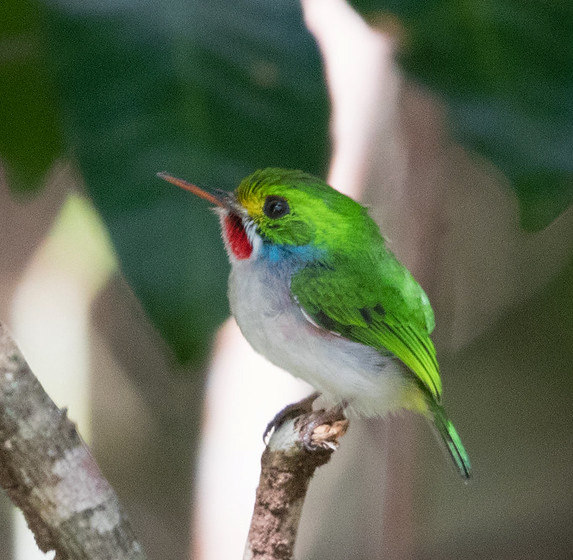 The Cuban tody thrives across various terrains, from damp thickets and woodlands to shaded riversides. Highly adaptable and non-migratory, these birds are fiercely territorial. Despite occasional human threats like pesticide spraying and subsistence hunting in impoverished areas, the Cuban tody remains a common sight across the island.A 2000 study in Cuba found the Cuban tody to be the most prevalent species among 49 surveyed, highlighting its widespread distribution. Fascinatingly, this species is known to be a “circumference species,” often grouping with other bird species. Genetic studies suggest that the Jamaican tody evolved from the Cuban tody, and fossil evidence discovered in southern Germany hints at a much broader historical range than previously believed.
The Cuban tody thrives across various terrains, from damp thickets and woodlands to shaded riversides. Highly adaptable and non-migratory, these birds are fiercely territorial. Despite occasional human threats like pesticide spraying and subsistence hunting in impoverished areas, the Cuban tody remains a common sight across the island.A 2000 study in Cuba found the Cuban tody to be the most prevalent species among 49 surveyed, highlighting its widespread distribution. Fascinatingly, this species is known to be a “circumference species,” often grouping with other bird species. Genetic studies suggest that the Jamaican tody evolved from the Cuban tody, and fossil evidence discovered in southern Germany hints at a much broader historical range than previously believed.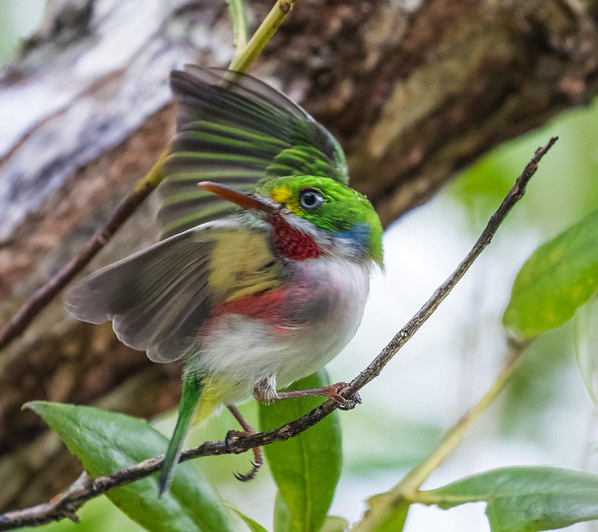 What sets the Cuban tody apart from many other birds is its tame demeanor. When encountering humans, it often pauses, bobs its head, and fixes its gaze on the observer before freezing in place—a behavior that endears it even more to bird lovers. With its brilliant rainbow-like plumage and pint-sized charm, the Cuban tody is truly one of Cuba’s most delightful natural wonders.
What sets the Cuban tody apart from many other birds is its tame demeanor. When encountering humans, it often pauses, bobs its head, and fixes its gaze on the observer before freezing in place—a behavior that endears it even more to bird lovers. With its brilliant rainbow-like plumage and pint-sized charm, the Cuban tody is truly one of Cuba’s most delightful natural wonders.
 Despite its vibrant appearance, spotting a Cuban tody in the wild is no easy task. Measuring just 34 mm from beak to the back of the head, and with a cranium barely 9 mm thick, it weighs only 6 to 6.5 grams—about the size of a stress ball. These birds are quick, agile, and prefer dense vegetation, making them elusive to photographers. When not perched in shady foliage, they dart through the air too fast for most cameras to catch.Cuban todies are also known for their unique vocalizations. They make three main types of sounds: a frequent, high-pitched “totting” call, a less common low-frequency note, and a wing-generated sound. Their typical song is a repetitive "tot-tot-tot" call that resembles an alarm. Interestingly, regional variations in their songs between eastern and western populations are believed to be genetically based.
Despite its vibrant appearance, spotting a Cuban tody in the wild is no easy task. Measuring just 34 mm from beak to the back of the head, and with a cranium barely 9 mm thick, it weighs only 6 to 6.5 grams—about the size of a stress ball. These birds are quick, agile, and prefer dense vegetation, making them elusive to photographers. When not perched in shady foliage, they dart through the air too fast for most cameras to catch.Cuban todies are also known for their unique vocalizations. They make three main types of sounds: a frequent, high-pitched “totting” call, a less common low-frequency note, and a wing-generated sound. Their typical song is a repetitive "tot-tot-tot" call that resembles an alarm. Interestingly, regional variations in their songs between eastern and western populations are believed to be genetically based. These birds are skilled insectivores and forage energetically throughout the day, often hunting nine feet or more above ground level. Their diet primarily consists of insects, but they also consume spiders, small lizards, and occasional fruit. Incredibly, they can catch up to one or two insects every minute. Their closest avian companions in habitat include the Loggerhead Kingbird and the Cuban Green Woodpecker. Natural predators are few, with mongooses and humans being their main threats.Cuban todies are resourceful nesters and typically build their homes in embankments or hollow tree trunks. Excavation begins as early as September, with both male and female birds taking turns digging tunnels. Interestingly, the first tunnels are used as night shelters while the egg-laying chambers are still under construction. The birds use a mix of grass, feathers, algae, and lichen to seal the tunnel walls and create curved entryways that deter predators. These burrows end in nesting chambers that usually hold two or three glossy, white, fragile-shelled eggs—the smallest among todies.Breeding season typically spans from April to June. During courtship, male todies show affection by exclusively feeding their mates. These bonding rituals mirror mating behaviors seen in other Cuban and North American bird species. Once bonded, the pair continues to share nesting and foraging responsibilities.
These birds are skilled insectivores and forage energetically throughout the day, often hunting nine feet or more above ground level. Their diet primarily consists of insects, but they also consume spiders, small lizards, and occasional fruit. Incredibly, they can catch up to one or two insects every minute. Their closest avian companions in habitat include the Loggerhead Kingbird and the Cuban Green Woodpecker. Natural predators are few, with mongooses and humans being their main threats.Cuban todies are resourceful nesters and typically build their homes in embankments or hollow tree trunks. Excavation begins as early as September, with both male and female birds taking turns digging tunnels. Interestingly, the first tunnels are used as night shelters while the egg-laying chambers are still under construction. The birds use a mix of grass, feathers, algae, and lichen to seal the tunnel walls and create curved entryways that deter predators. These burrows end in nesting chambers that usually hold two or three glossy, white, fragile-shelled eggs—the smallest among todies.Breeding season typically spans from April to June. During courtship, male todies show affection by exclusively feeding their mates. These bonding rituals mirror mating behaviors seen in other Cuban and North American bird species. Once bonded, the pair continues to share nesting and foraging responsibilities. The Cuban tody thrives across various terrains, from damp thickets and woodlands to shaded riversides. Highly adaptable and non-migratory, these birds are fiercely territorial. Despite occasional human threats like pesticide spraying and subsistence hunting in impoverished areas, the Cuban tody remains a common sight across the island.A 2000 study in Cuba found the Cuban tody to be the most prevalent species among 49 surveyed, highlighting its widespread distribution. Fascinatingly, this species is known to be a “circumference species,” often grouping with other bird species. Genetic studies suggest that the Jamaican tody evolved from the Cuban tody, and fossil evidence discovered in southern Germany hints at a much broader historical range than previously believed.
The Cuban tody thrives across various terrains, from damp thickets and woodlands to shaded riversides. Highly adaptable and non-migratory, these birds are fiercely territorial. Despite occasional human threats like pesticide spraying and subsistence hunting in impoverished areas, the Cuban tody remains a common sight across the island.A 2000 study in Cuba found the Cuban tody to be the most prevalent species among 49 surveyed, highlighting its widespread distribution. Fascinatingly, this species is known to be a “circumference species,” often grouping with other bird species. Genetic studies suggest that the Jamaican tody evolved from the Cuban tody, and fossil evidence discovered in southern Germany hints at a much broader historical range than previously believed. What sets the Cuban tody apart from many other birds is its tame demeanor. When encountering humans, it often pauses, bobs its head, and fixes its gaze on the observer before freezing in place—a behavior that endears it even more to bird lovers. With its brilliant rainbow-like plumage and pint-sized charm, the Cuban tody is truly one of Cuba’s most delightful natural wonders.
What sets the Cuban tody apart from many other birds is its tame demeanor. When encountering humans, it often pauses, bobs its head, and fixes its gaze on the observer before freezing in place—a behavior that endears it even more to bird lovers. With its brilliant rainbow-like plumage and pint-sized charm, the Cuban tody is truly one of Cuba’s most delightful natural wonders.